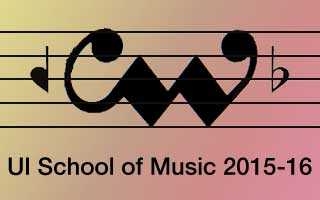
Concerts XVI
Composers' Workshop
Sunday, May 8, 2016, 7:30 p.m.
Riverside Recital Hall (map)
Program
The Raven
Alex KANE [BIO]
This piece combines spoken word and flute performance elements to create something resembling a narrative collage/mosaic, based on the poem of the same name by Edgar Allen Poe. Several intertwined themes represent the angst and complexity of the psyche of a man whose lover, Lenore, has died, and who is now tormented by a Raven sitting upon a bust in his private chamber. This tormented man must interpret the one monotonous word that the Raven continually repeats: “Nevermore”. His curiosity and angst soon overwhelm him as he goes mad with trying to figure out the meaning of that ambiguous statement.
At A Standstill
Alexander TOTH [BIO]
Hannah Kauffmann, soprano
Elizabeth Nelson, alto
Christopher Nakielski, tenor
Benjamin Ross, bass
Elizabeth Nelson, alto
Christopher Nakielski, tenor
Benjamin Ross, bass
Menashe’s text features a neutral figure ensconced in solitude, yet he somehow seems to be maintaining a conversation. Though I originally set this piece to a more tonal style, upon reexamination, I felt a more appropriate way to treat the text and re-wrote the piece as a palimpsest, retaining only pitches and the melodic line from what I originally composed. Although there are four voices, they often act as one, sharing pitches, consonants, and rhythms within and around the text. I picked both strong and soft consonants to be perpetuated and stretched throughout the piece to elongate the passage of time within the short poem, accentuate the persona’s attention to his surroundings, and provide commentary on whether or not the speaker is truly alone.
Branch
Carlos COTALLO SOLARES [BIO]
Craig Hatter, percussion
Andrew McDonald, percussion
Shelby Tracy, percussion
Kelvin Tran, percussion
Andrew McDonald, percussion
Shelby Tracy, percussion
Kelvin Tran, percussion
Branch mainly concentrates on the subjects of polyphony and synchronicity. Throughout the piece, the four percussionists go from behaving like a single musician to becoming more and more independent from each other, playing together the same rhythm at first, then different parts of a single gesture, and finally performing the same process uncoordinately, resulting in four individual tempi coexisting at the same time.
The Word Unspoken
Alexander SPENCERI [BIO]
Alexander Spenceri, euphonium,
Linguistic communication is flawed, and often we find ourselves unable to complete our own trains of thought. This piece deals with this breakdown in communication. As ideas are formulated from the ether, they quickly disappear before being completed, and are replaced by other motives with theoretical, but hardly tangible relationships. The piece opens with the spelling of a tone row, which is then separated into three pitch-class sets which make up the three segments of the piece. The motivic ideas presented are otherwise nearly unrelated, and are connected by the extended technique from which these thoughts are spawned, as our minds create marginally related ideas at high speeds with often little sign of outward coherency. This is Alexander’s first complete composition.
Cognatic
Jacob P. SIMMONS [BIO]
From similar and complimentary pitch collections, two flutes embark down closely related paths of gradual transformation. Textural metamorphosis occurs in both voices congruently, yet at differing rates. This metamorphosis explores divergencies in register, rhythmic character, density, and timbre. Likewise, both pitch collections are transformed through gradual reduction proceeded by reconstruction, until finally set A becomes set B, and vice versa. Antithetical to the prominence of homogeny in Cognatic, each voice is given a unique element (a motive, or a distinct type of gesture) that recurs aperiodically throughout the piece, functioning as an interruptive factor in an otherwise fluid stream of transformation.
Three Grey Pictures
Luke KOTTEMANN [BIO]
I. Dense Fog
II. Empty Spaces
III. Old Stones
II. Empty Spaces
III. Old Stones
Kelsey Platt, violin
Bethany Wheeler, harp
Bethany Wheeler, harp
Following a recent road trip to Michigan’s Upper Peninsula, I became enamored with the color grey. The entire vacation was filled with dreary, yet strangely beautiful scenes. Three Grey Pictures is an attempt to paint some of my favorite scenes from the Upper Peninsula. The first movement, Dense Fog, is inspired from seeing fog roll between the Iron Mountains. The second movement depicts the vastness of Lake Superior. When the fog was especially thick, it was impossible to see the horizon between the lake and the sky, creating a grey empty space. The third movement portrays the forgotten, abandoned buildings that are prevalent in this remote place. Today, all that is left of these buildings are old stone walls left to crumble. I made the third movement a dance to create the image of an old building that was once a social hall, where people would get married, dance, and live their lives. As time goes on, the stone walls are beat down and erode away, creating only a distant memory of the dance. Soon, even the memory is lost in dense fog. In all three of these pictures, the color grey is central to their mysterious beauty. Grey’s ambiguous quality is imitated in Three Grey Pictures by a mixture of major and minor thirds and many minor seconds. Thus, although all these pictures are different images, they all share the same grey colors.